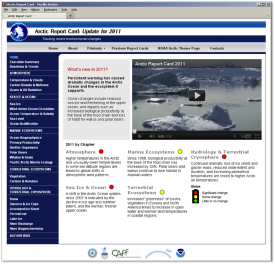
The National Oceanic and Atmospheric Administration (NOAA) has released the 2011 Arctic Report Card. The report reflects the published and ongoing work of an international team of researchers and includes a range of arctic environmental observations. The report is organized around five chapters, which discuss changes observed in the atmosphere, sea ice and ocean, marine ecosystems, terrestrial ecosystems, and hydrology and terrestrial cryosphere.
Chapter highlights from the 2011 report include:
Higher temperatures in the Arctic and unusually lower temperatures in some low latitude regions are linked to global shifts in atmospheric wind patterns.
A shift in the Arctic Ocean system since 2007 is indicated by a decline in sea ice thickness and summer extent, and a warmer and fresher upper ocean.
Marine ecosystem observations suggest profound and continuing changes, such as a 20% increase in biological productivity at the base of the food chain since 1998.
An increase of tundra vegetation in Eurasia and North America is linked to an increase in open water and warmer terrestrial temperatures in coastal regions.
Continued loss of ice sheet and glacier mass, reduced snow extent and duration, and increasing temperatures of permafrost are linked to higher arctic air temperatures.
To read the 2011 Arctic Report Card, an executive summary, and previous Arctic Report Cards please go to: http://www.arctic.noaa.gov/reportcard/index.html.
